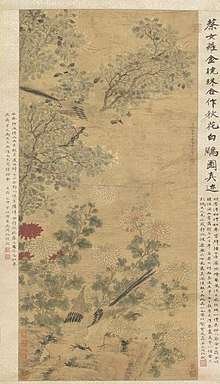Cai Han
Cai Han (Chinese: 蔡含; 1647–1686), was a Chinese landscape painter. She was the concubine of the painter Mao Xiang and, with his other concubine Jin Yue, she was commissioned by him with the task of producing paintings as gifts to his guests; they became known as "The Two Painters of the Mao Family".
Cai Han 蔡含 | |
|---|---|
| Born | 1647 |
| Died | 1686 (aged 38–39) |
| Nationality | Chinese |
Notable work | Auspicious noon (午瑞图) |
| Style | Chinese landscape paintings |
| Spouse(s) | Mao Bijiang |
Names
Cai Han's courtesy name on attaining adulthood was Nüluo (Chinese: 女蘿). She also went by her art name of Yuanyu (Chinese: 園玉).[1]
Biography
Cai was the daughter of a member of staff in the house of Mao Xiang in Rugao. Sometime during the reign of the Shunzhi Emperor, an artist from Suzhou called Wu Ruixian (Chinese: 吳蕊仙) sought refuge with Mao. Wu taught Cai to paint and write poetry.[2] Around 1661, Cai became one of Mao's concubines, along with Jin Yue (Chinese: 金鈅). The two women collaborated on many compositions, earning renown as 'the two artists of the Mao family' (Chinese: 冒氏兩畫史).[2]
Art

Cai Han was particularly well-known for her landscape paintings.[1] The Guochao Hua Zheng Xulü (Chinese: 国朝画徵续录) described Cai as, 'particularly good at painting landscapes, flowers, animals, and birds,' and, 'adept at imitations.'[3] She painted many pieces together with her fellow concubine Jin Yue 金鈅, including Auspicious noon, now held in the Nanjing Museum.[1] In her depictions of people, Xie Li identifies the influence of Tang Yin on Cai's technique.[1] In 2001, one of Cai's works painted in 1680, titled Shuihui yuan tu (Chinese: 水繪園圖), appeared at an auction house in Shanghai, where it was sold for 40,000 RMB[4] to an unknown buyer.[2]
References
Notes
- Xie (1988), p. 43.
- "书画系列:刘聪泉《丹青写意水绘园》" [Painting and calligraphy series: Liu Congquan's "Garden of freehand and watercolour painting"]. Nantong Shuhua Wang (in Chinese). 20 January 2014. Retrieved 2 September 2017.
- Guochao Hua Zheng Xulü (1636–1912), section Ruixiu cai he jin xiaozhu: 兼善山水花草禽城長於臨摹
- Approximately 6100 USD, or 5140 EUR, at the time.
Works cited
- Lily Xiao Hong Lee; Clara Lau; A.D. Stefanowska (17 July 2015). Biographical Dictionary of Chinese Women: v. 1: The Qing Period, 1644-1911. Taylor & Francis. ISBN 978-1-317-47587-3.
- Xie 谢, Li 荔 (1988). "蔡含的山水图赏析" [Appreciation of Cai Han's landscape pictures]. Sichuan Wenwu (in Chinese) (6).
- Zhang 張, Geng 庚, ed. (1636–1912). 国朝画徵续录 [A replenished record of evidence for the nation's art] (in Chinese). Retrieved 1 September 2017.